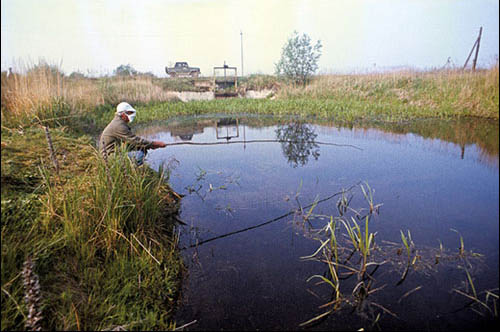La plus grande catastrophe industrielle de l’histoire de l’humanité
This post is also available in:
 French
French
“L’accident de Tchernobyl“
Que s’est-il passé exactement à la centrale? Quelles mesures ont été prises pour organiser la “liquidation\" des suites de ce l’on appelle officiellement “l’accident de Tchernobyl ” Comment la réalité de Tchernobyl a-t-elle mis à l’épreuve la politique de transparence inaugurée par Mikhail Gorbachov ? Pourquoi a-t-il été nécessaire d’évacuer 600 villes et villages et de reloger de façon permanente 350 000 personnes? Qu’est-il advenu des animaux et des plantes restés sur place ? Comment vit-on au “Pays de Tchernobyl”, avec une contamination qui perdure sur 160 000 km2? Quels sont les problèmes de santé et les conséquences à long terme ? Comment l’équipe de chercheurs en “ethnographie de l’extrême” tente-t-elle de reconstituer une “Atlantide ukrainienne”, le patrimoine culturel de ce qui était autrefois la Polésie, entre l’Ukraine et le Bélarus ? C’est à ces questions parmi tant d’autres que l’exposition tente de répondre. Chernobyl, 20 Years On
Twenty years after the disaster, Chernobyl has become a myth, a symbol, a key word. However, unlike other major natural or technogenic catastrophes, this is an ongoing disaster, and we still do not know the true scope of the damage, particularly with regard to the health of the nine million people who live in this area, which remains contaminated and includes the territories of Belarus, the Ukraine and Russia.
· What really happened on the fateful night of 26 April 1986?
· How did the “battle of Chernobyl” unfold against the invisible enemy, the atom?
· Who were the “liquidators”, the million men and women who waged an attack on radioactivity?
· How did the government handle this major crisis that undermined the Soviet Union?
· How does the civilian population live in the contaminated areas?
· What is happening to the animals and plants in this post-industrial world abandoned by man?
Welcome to the world of Chernobyl! : The ”Chernobyl accident”
What exactly happened at the power station? What action was taken to manage the “liquidation” of the consequences of what is called officially “the Chernobyl accident” How did the reality of Chernobyl become a fearsome test for the policy of glasnost launched by Mikhail Gorbachov? Why was it necessary to evacuate some 600 towns and villages, and permanently relocate 350,000 persons? What happened to the animals and plants? How do people live in “Chernobyl-land”, with its lasting contamination of a total surface area of 160,000 km? What are the health problems and the long-term consequences? How is a team of researchers devoted to “extreme ethnography” salvaging a “Ukrainian Atlantis”, the culture of the former region of Polesia, which spreads between Ukraine and Belarus? The challenge facing this exhibition is to answer these questions among many others. Érase una vez Chernóbil
Chernóbil, 20 años después
Veinte años después de la catástrofe, Chernóbil se convierte en un mito, un símbolo, una palabra clave. Pero, a diferencia de otros grandes desastres naturales o tecnógenos, Chernóbil es una catástrofe en proceso, de la que todavía no se conoce el verdadero alcance de los daños, en particular para la salud de nueve millones de personas que siguen viviendo en los territorios aún contaminados, en Bielorrusia, en Ucrania, en Rusia.
· ¿Qué ocurrió realmente la fatídica noche del 26 de abril de 1986?
· ¿Cómo se desarrolló la “batalla de Chernóbil” contra el enemigo invisible, el átomo?
· ¿Quiénes eran esos “liquidadores”, ese millón de hombres y mujeres lanzados al asalto de la radioactividad?
· ¿Cómo se gestionó políticamente esa crisis capital que minó a la Unión Soviética?
· ¿Cómo vive la población civil en las zonas contaminadas?
· ¿Qué les ocurre a los animales y a las plantas en el universo postindustrial abandonado por el hombre?
¡Bienvenidos al universo de Chernóbil! ”El accidente”
Durante la noche del 25 al 26 de abril de 1986, el personal de la central de Chernóbil se disponía a detener el reactor, para realizar labores de mantenimiento. Pero antes de proceder a la parada, se realizó un experimento productivista. Éste se desarrolló con normalidad y después, a la 1 h 23 min 4 s, el reactor “se embaló” de repente. Su potencia se disparó. 34 segundos después, el operador jefe, Akimov, intentó detener el reactor. Pero una aceleración enloquecida siguió su curso. En un intervalo de pocos segundos, dos enormes explosiones sacudieron el reactor y la sala de máquinas. ¿Qué ocurrió? ¿Fallos del personal? ¿Cálculos erróneos para el experimento? ¿Inestabilidad del reactor RBMK? ¿Cortocircuito en la sala de máquinas? Habida cuenta de que la catástrofe es un acontecimiento único y que no se puede reproducir, nunca se sabrá con certeza las razones de la mayor catástrofe industrial del mundo moderno.
Nueve millones de personas, de las que más de dos millones son niños, viven en los territorios contaminados, que abarcan más de 13.000 localidades. La zona afectada por la catástrofe de Chernóbil ocupa una superficie de 160.000 km².
From 17/05/2006 to 08/10/2006
CCCB de Barcelone
CENTRE DE CULTURA CONTEMPORANIA BARCELONA
Montalegre 5
08001 Barcelone
Espagne
Opening hours : Mardi, jeudi et vendredi : 11h à 14h et 16h à 20h. Mercredi, samedi : 11h à 20h.
Phone : + 34 93 306 41 00
mbetoret@cccb.org
www.cccb.org/eng/premsa/arxiu.htm



